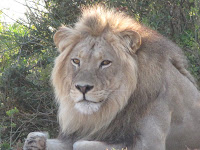In our provisions for Addo was a huge bag of oranges and when we got the the Matyholweni gate to enter the park there was a huge sign saying "No citrus allowed in the park". We handed the bag over and could collect it on our way out. We were trying to work out why it was not allowed but couldn't think of anything obvious.
The park is divided by a road and we didn't see any animals in the first part of the park. No sooner had we crossed into the second park when we saw dozens of elephants. There are over 500 according to the literature.
The accommodation area has a huge electric fence separating it from the animals in the park. There are various types of accommodation available as well as a petrol pump, small shop and restaurant. We pitched our tent in the camping area which has a tent area and larger sites for campervan and caravans. There was a kitchen with 3 cook tops and a freezer but no fridge. No crockery or cutlery is provided so we were able to use our own having carried them this far.
The ablutions were very clean and comfortable even providing an area to do laundry. Our camp site had its own bbq and we had to pitch our tent on the gravel. In such dry conditions I could never imagine our park rangers providing bbqs for visitors for fear of the danger of a bush fire.
After the park closed for the night we were able to watch the birds in the bird hide overlooking a pond. There were dozens of weaver birds going in and out of their nests and sunbirds eating nector from the flowers. As the sunset on the animal hide we could see a few bucks and Egyptian geese but not much else came to visit.
We really enjoyed driving around the park and were able to tick of quite a few animals on the list they gave us. We would get up early and drive about and then return for breakfast, shower, do our laundry and then head out again with our lunch in the car and return just before the gates closed for the night.
There is a board near reception that lists the animals spotted that day and where they were. So early in the morning we would head for the spots where the lions were seen. We got lucky and as we drove along we met a huge beautiful lion just as he was coming out of the trees at the moment we passed. He towered over our little car and he and I were eye-to-eye through the passenger window and that got me gasping. We turned around and followed him along the road and then he sat and looked at us giving us his best poses. What a buzz!
Another day we saw a young warthog being attacked by two jackals. One jackal would bite at the hog's left hip and the hog would turn towards the attacking hog. While he was doing this the second hog would bite his right hip and so it went on until the jackals were able to drag the hog a few centimetres and tire him out. At one point a large warthog went over to the injured hog and sniffed him or licked him while the jackals hovered nearby. However he left the young hog to his fate and the jackals continued their torture. Later we returned and there was nothing left of the hog and no jackals either.
There were several senior South African folk in the camp as there was some discount for them and we would chat with them when we met in the kitchen in the evenings. As we unpacked our food we found one orange that had fallen out of the bag so we quickly consumed it out of sight of any of the staff. The nights were quite cold and sometimes misty but it warmed later in the day.
We were able to read about the history of the park and found the reason why we were not allowed any citrus. In 1931, there were only 11 elephants when the park was established. The fencing was inadequate and the elephants annoyed the local farmers. The park manager began feeding the elephants oranges, hay, pumpkins and lucerne at set times to keep them in the park.
When the food trucks arrived the elphants would run behind trumpeting and grabbing the oranges from the trucks. The vegetation around the feeding areas became decimated as the elephants wouldn't move away in case they missed the feeds. Levels of aggression between elephants rose and many were injured. They showed signs of stress by the secretions from their temporal glands when competing for oranges and as a consequence feeding citrus was stopped in 1979.
We were glad we found the rogue orange before some old elephant with an amazing memory could smell it and chase us trumpeting around the park.



